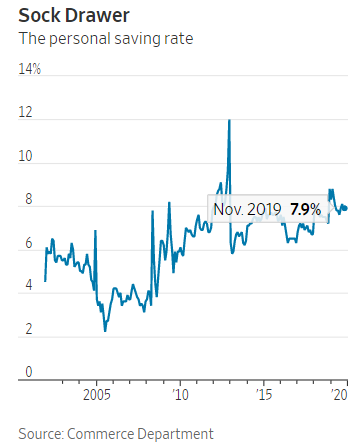With Americans unwilling to run down savings and the job market slowing, consumer spending has everything to do with wages
By Justin Lahart

Consumer spending can only grow about as fast incomes can. Photo: Jeff Chiu/Associated Press
The only way to get people to spend more money these days is to pay them more.
Americans spent a bit more freely in November, with the Commerce Department on Friday reporting that personal-consumption expenditures rose a seasonally adjusted 0.4% from a month earlier after rising 0.3% in October. The consumer still isn’t dead.
The November spending gain was topped by a 0.5% increase in personal income.
As a result, the personal saving rate ticked up to 7.9% from 7.8%—around its average level over the past two years.
The relatively high saving rate is one of the things that sets this economic expansion apart.
Unlike in the 1990s and the early 2000s, when people responded to ongoing improvement in the economy and job market by saving less and less, they continue to play it safe.
The higher saving rate should make it easier for Americans to ride out any downturn than in the past, so it mostly counts as a good thing.
But barring a sudden bout of profligacy, it also means that consumer spending can only grow about as fast incomes can.
That could pose a challenge in the year ahead.
The problem is that the job market, while strong, has been slowing.
In November, there were 2.2 million more U.S. jobs than a year earlier, which compares with a gain of 2.7 million jobs in 2018.
With the unemployment rate at just 3.5%, hiring will likely further moderate next year—even where jobs are available, it is getting harder to fill them.
That matters because the biggest drivers of overall U.S. income gains are job growth and wage growth. So if annual wage growth doesn’t pick up—over the past year or so, it has been stuck at a little over 3%, as measured by average hourly earnings—income growth will slow.
And spending growth will slow, too.

0 comments:
Publicar un comentario